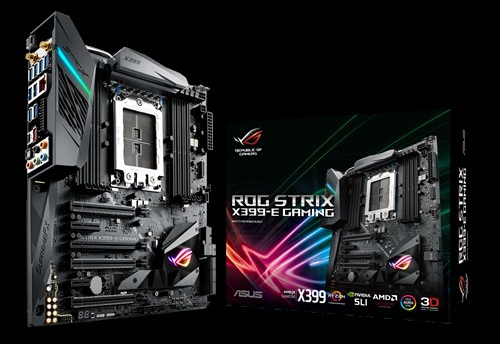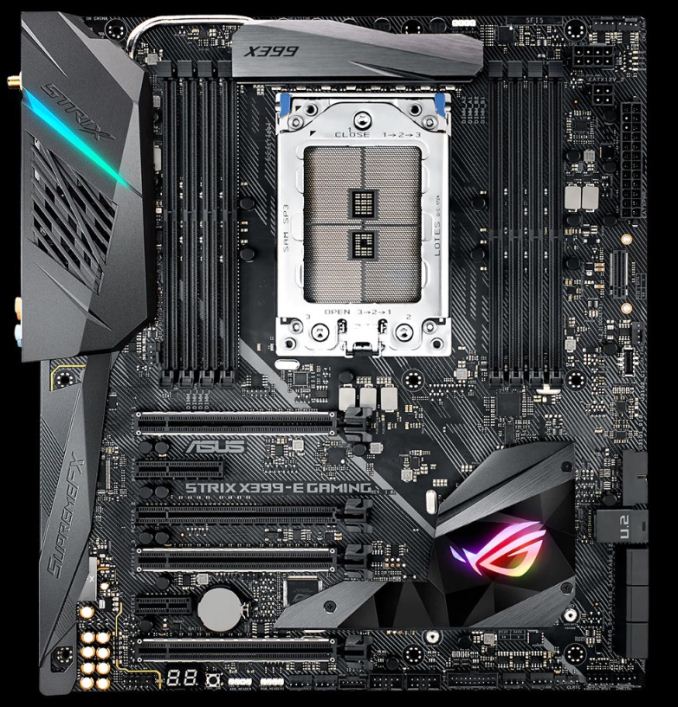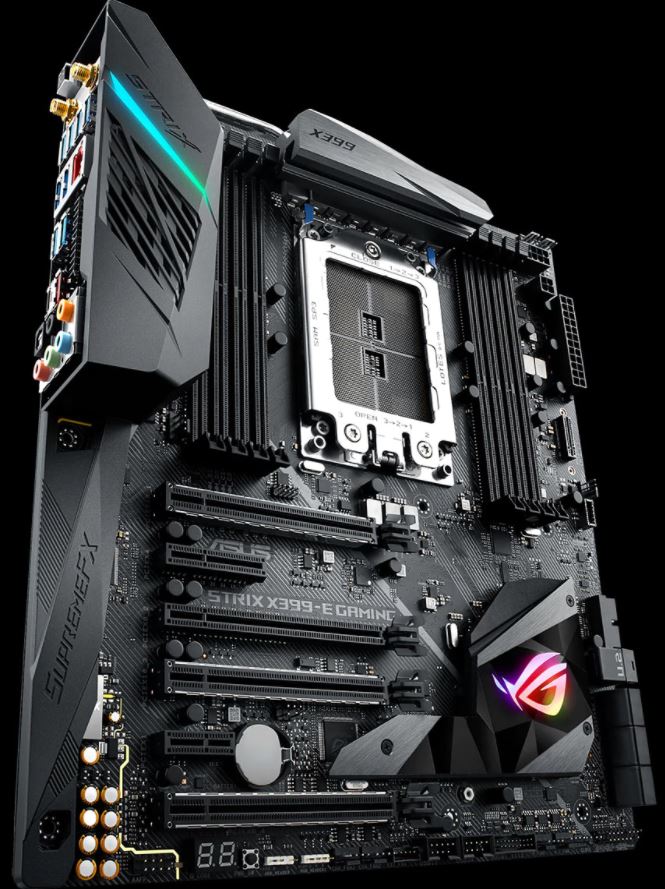An AMD Threadripper X399 Motherboard Overview: A Quick Look at Seven Products
by Ian Cutress & Joe Shields on September 15, 2017 9:00 AM ESTASUS ROG Strix X399-E Gaming
With the advent of eSports and the ability to stream and even broadcast your own gaming sessions, PC gaming has gained a significant amount of momentum the past few years. So much so, many (if not all) of the motherboard partners have latched on to the nomenclature and started entire lines for 'gaming' motherboards. ASUS is no different with gaming based motherboards, out for generations now under the ROG name, and continues to do so on the X399 Threadripper platform in the ROG Strix X399-E Gaming. Strix as a brand has migrated from a 'zero-noise' implementation to the more budget oriented gaming products from ASUS.
The ROG Strix falls between the Zenith Extreme and the Prime with a mix of features. For example, the Strix includes WiFi and Bluetooth connectivity, like the flagship Zenith Extreme, or that the Prime and Strix each have a single Intel I211-AT Gigabit LAN while the Zenith has three network ports including a 10 GbE. The Strix X399-E Gaming has eight DRAM slots, supports multiple GPUs (SLI and Crossfire), uses the latest audio codec (Supreme FX S1220A for the Strix), a capable VRM, multiple storage options, and RGB lighting among other features.
Looking over the board in detail, we'll start at the top. First, the VRM configuration is an eight-phase design. It is cooled by dual heat sinks running along the top of the socket with the second sitting between the memory slots and rear I/O. Extra cooling on the VRMs is provided by an included 40mm fan sitting under the I/O shroud (similar to the Zenith). Both EPS connectors, an 8-pin and 4-pin, as well as the 24-pin ATX connector, are in the top right-hand corner of the board. Below that is the second M.2 slot. An M.2 drive in this slot, like in the Prime, sticks out from the board instead of laying flat. ASUS does include an M.2 bracket for the slot to assist with supporting the standing device.
Continuing to move down the motherboard, below the vertical M.2 slot is the USB3.1 (10 Gbps) header fed from the chipset. For cases that have front panel USB 3.1 ports, this is typically the header used for that connectivity. Below that is the single U.2 port and six SATA ports.
The chipset heatsink on the ROG Strix houses RGB LEDs that can be adjusted with the AURA Sync software. The only other LEDs on the board are located on the I/O cover. The chipset heatsink extends on the bottom between the last two full-length PCIe slots and covers the first M.2 slot providing additional cooling for those devices.
The Strix offers four full-length PCIe slots, three use a reinforcing guard and is where users will slot their graphics cards for optimal performance. The PCIe arrangement allows for up to a triple slot video card between slot 1 and slot 3, and a dual slot card will fit between between slot 3 and slot 4. Slot breakdowns are x16 for single, x16/x16 for dual GPUs, and x16/x16/x8 when using three GPUs. Additionally there is one PCIe x1 slot, a PCIe x4 slot, and full-length PCIe slot (x4). These slots distinguish themselves by not having the reinforcement.
Across the bottom of the board are more onboard headers. These include external addressable RGB LED headers, fan headers, and USB3.0 headers. It also has a debug display as well as a small power button for testing outside of the case. On the left side of the board is where the audio parts are housed. Mostly concealed under the shroud is an EMI protected ALC1220A codec using upgraded filter caps, and PCB separation of the audio components from the rest of the board.
The rear I/O panel is fairly busy with a BIOS reset button, wireless connectivity, eight USB 3.0 ports, and the Gigabit Ethernet port taking up most of the real estate. USB 3.1 Type-A and Type-C ports from the ASMedia controller are also present, with the audio jacks, including SPDIF output, rounding out the rear panel.
| ASUS ROG Strix X399-E Gaming | |
| Warranty Period | 3 Years |
| Product Page | Link |
| Price | N/A |
| Size | ATX |
| CPU Interface | TR4 |
| Chipset | AMD X399 |
| Memory Slots (DDR4) | Eight DDR4 Supporting 128GB Quad Channel Up to 4133 MHz (OC) |
| Network Connectivity | 1 x Intel I211-AT GbE |
| Wireless Network | Wi-Fi 802.11 a/b/g/n/ac |
| Onboard Audio | SupremeFX S1220A |
| PCIe Slots for Graphics (from CPU) | 4 x PCIe 3.0 x16 Supports SLI/CF |
| PCIe Slots for Other (from Chipset) | 1 x PCIe 2.0 x4 (max) 1 x PCIe 2.0 x1 |
| Onboard SATA | 6x Supporting RAID 0/1/10 |
| Onboard SATA Express | None |
| Onboard M.2 | 2 x PCIe 3.0 x4 - PCIe or SATA |
| Onboard U.2 | 1 x PCIe 3.0 x4 |
| USB 3.1 | 1 x Header 1 x Rear Panel Type-A 1 x Rear Panel Type-C |
| USB 3.0 | 8 x Rear-Panel 2 x Header |
| USB 2.0 | 2 x Header |
| Power Connectors | 1 x 24-pin EATX 1 x 8-pin ATX 12V 1 x 4-pin ATX 12V |
| Fan Headers | 1 x M.2 1 x CPU 1 x CPU OPT 3 x Chassis 1 x AIO_PUMP 1 X w_PUMP+ 1 x 5-pin EXT_FAN |
| IO Panel | 1 x Intel NIC 1 x USB 3.1 Type-A 1 x USB 3.1 Type-C 8 x USB 3.0 1 x Optical S/PDIF out 5 x Audio jacks 1 x USB BIOS Flashback Button 1 x 2x2 Wi-Fi 802.11 a/b/g/n/ac |
ASUS mentioned pricing for the Strix X399-E Gaming to be at a more affordable price than their flaghsip ROG Zenith Extreme. It is currently available through smaller distributors, perhaps as a pre-order, but not found on Newegg or Amazon at the time of writing (9/11).













99 Comments
View All Comments
CityBlue - Saturday, September 16, 2017 - link
The noisy 40mm fan is a major deal breaker for me - what are ASUS thinking by including this? They should add better passive cooling - I don't need the stupid little fan failing or becoming less effective in 2-3 years, leading to random instability.Real shame as my last two motherboards (Intel and AMD) have been from ASUS and I've been really happy, but for Threadripper they're off my list until they design a passively cooled motherboard.
mapesdhs - Tuesday, September 19, 2017 - link
Must admit I quite the look of that Gigabyte Designare-EX, and likewise until now almost all my boards have been ASUS (except for some X58/P55 boards from Asrock, though I have three top-end ASUS P55 boards aswell).I note the absence of EVGA. Have they basically quit the mbd business?
Threska - Sunday, September 17, 2017 - link
Nice, but one deficiency that's carried through a lot of boards is dealing with headers. The writing's tiny. The locations are difficult even if the boards not populated. Documentation a lot of times isn't clear. The one good thing is that it's usually done only once (build time).prisonerX - Monday, September 18, 2017 - link
You need the motherboard equivalent of a large print book.Threska - Monday, September 18, 2017 - link
Endoscope actually, but not everyone has those.msroadkill612 - Saturday, September 23, 2017 - link
A large print, e-atx atx.peevee - Monday, September 18, 2017 - link
Sorry, but $350-550 for a dumb, single-socket, homebound motherboard is insane.satai - Monday, September 18, 2017 - link
What don't you get on "HEDT"?You probably don't need it/don't have money for it. Some people do.
mapesdhs - Tuesday, September 19, 2017 - link
He's either trolling or just ignorant. I know a guy who has MS, got a PhD in a relevant discipline and now does research on his own condition. A TR board would be ideal for the work he does, using lots of GPUs for compute, etc. (biomedical apps) Then there are those who game but also want to stream and encode, and of course solo professionals who can't afford dual-socket XEONs or Opteron-type boards. And plenty of people work at home, so the location of a system at home means nothing. I have a 36-CPU supercomputer in my garage. :Dwiyosaya - Monday, September 18, 2017 - link
The MSI Pro Carbon looks like it has 4 PCI-e 3.0 X16 slots from the diagram in the article. I have to wonder whether those slots are actually electrically X16 slots or some other configuration. I have not been able to find any information on their site or in this article that gives the electrical configuration of those slots. Anyone know for sure?